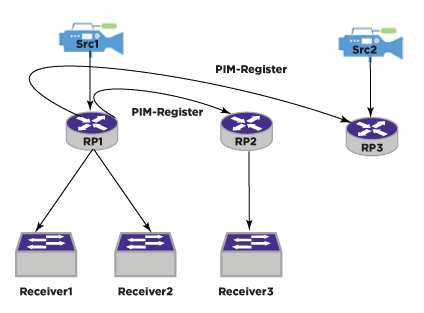Anycast Rendezvous Point (RP) Using PIM (RFC 4610)
Anycast Rendezvous Point (RP) Using PIM (RFC 4610) provides fast convergence when RP routers fail using PIM protocol without using the source discovery protocol Multicast Source Discovery Protocol (MSDP) for both IPv4 and IPv6 address families.
- Need support for IPv6 address family, which MSDP does not support.
- Interdomain connection is not required.
- Do not wish to deploy MSDP protocol.
The feature requires a Premier or Core license. For more information about licensing, see the Switch Engine 32.7.1 Feature License Requirements .

Anycast RP is a mechanism that provides fast convergence when a PIM RP node fails. Receivers and sources connect to the closest RP. The packets from a source need to get to all RPs to find joined receivers.
A unicast address is selected as the RP address. Multicast groups supported by the RP are configured using a policy file. This RP is configured either statically, or is dynamically distributed to the PIM domain using BSR protocol. To achieve the load balancing between the RPs, the same RP address is configured to multiple devices in a PIM domain. Sources and receivers connect to the nearest router selected by the L3 unicast routing protocols.
In the above topology, three RP nodes are configured with the same RP address. Recevier1 and Receiver2 choose RP1 as the nearest router. Recevier3 connects to RP2. When Source1 starts transmitting, Src1 node start sending the register requests to RP1. The same sources should be known to other receivers, such as Receiver3. Typically, in IPv4, MSDP protocol is used to propagate the learned sources from RP1 to other RPs (RP2 and RP3) through MSDP messages.
In the above topology, each node configured with an Anycast RP address and a unique unicast IP address can communicate with other Anycast RP peers configured using the policy file (see Anycast RP Using PIM Policy File Information. Anycast RP addresses and the group of nodes' unique address bindings are called an Anycast RP set. Each RP communicates with other nodes in the same RP set.
Anycast RP Using PIM Policy File Information
The policy file contains a list of Anycast RP peer addresses, and should be in the following format. This same policy must be attached to the all the RP Anycast RP peers participating in the Anycast RP set.
Sample Policy File
entry policy1 {
if match any{
nlri 10.10.10.1/32;
nlri 20.20.20.1/32;
nlri 30.30.30.1/32;
}
then {
permit;
}
}
Supported Platforms
This feature is available on platforms that support the appropriate license for the PIM feature. For complete information about software licensing, including how to obtain and upgrade your license and which licenses support the PIM feature, see the Switch Engine 32.7.1 Feature License Requirements .
Limitations
- Configuring MSDP peers between the Anycast RPs might not work as expected. Anycast RP Using PIM removes the dependence on using MSDP by removing MSDP peering between the Anycast-RPs.
- Register policy on an RP will reject the register source or groups mentioned in the policy file. If Anycast RP is configured on the same node, register policy takes precedence over the Anycast RP. Register policy filter is applied on all the PIM-Register messages received from either first hop router (FHR) or other Anycast RP peers.
- If RP is configured on an MLAG node, the peer node must not be configured as Anycast RP peer.
- Configuring Anycast RP, see Configuring Anycast RP Using PIM (RFC 46010).
- Viewing Anycast RP information, see Displaying Anycast Rendezvous Point (RP) Using PIM (RFC 4610).

